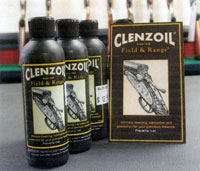
The Gazette
IN THE GUN ROOM • spring Cleaning • Clenzoil |
| Keep
it Working, Keep it Clean |
||
If these residues are left in the barrels corrosion and poor patterns can occur. The corrosion caused by the plastic fouling creates a layer the length of the barrel under which the combination of un-burnt powder (soot) and condensation is trapped. Lead build-up, particularly at the muzzles, can increase the degree of choke present in the gun and if a non-concentric build-up occurs, it will disrupt patterns. So, not only to protect your investment but also to maintain its performance, you need to clean your gun after every outing. What is required is a simple but effective routine. First, if the gun is wet, do not place it in a gun slip or case- wipe it off with a paper towel or rag and allow it to breathe. It is amazing how a gun that looks dry, will weep moisture several hours later. It is good to leave the gun to stand in an ambient temperature for a few hours before cleaning. |
At home, I break the gun down into its component parts and beginning with the barrels, remove the choke tubes, if fitted, placing them in a jar of solvent.I then spray a squirt of solvent cleaner into each barrel to soften up the soot, lead and plastic fouling. Placing the barrels to one side to allow that to begin its work, I turn my attention to the action. I clean out any foreign bodies and un-burnt powder and wipe off the interior and exterior and finally give it a coating of quality oil. This is repeated with the forend iron. I like to wipe off the woodwork, brush out the chequering with a stiff brush and apply a small dab of boiled linseed or proprietary stock oil, massaging it with the palm of my hand into the finish by the heat generated. Be sparing - it is amazing how far a drop of stock oil will go! Be sure to keep it out of the chequering and before putting the gun away, examine for any surplus, and buff this off. (A piece of chamois leather and a sprinkle of rotten stone will remove both excessive dried oil and any small scratches and marks). Every month I apply a little stock wax. |
Placing a smear of gun grease on the knuckle and lugs of the action, I r-assemble the gun. I personally like to store my guns muzzle down in the safe. This way, the oil in the barrels cannot capillary down and through the striker holes and into the action and the head of the stock, as when the gun is stored barrels up. Keep a golden rod in the safe, to avoid the condensation inevitable with living in the South. When you next take the gun out, be sure to run a jag through the bores to remove the excess oil before use. Have the gun stripped, cleaned and examined annually, to check for any wear and tear that is not apparent without taking the gun apart. The best way to keep your gun working, is to keep it clean! |
Clenzoil |
||
We have known Doug
Roberson, owner of McGregor Wing and Clay in Cary, North Carolina
for some time and when he recommends a product, as the old ad used
to say, we listen! We recently saw him at a shoot in South Carolina and when we asked him the rhetorical question “What’s new?” he surprised us with his enthusiastic reply…”CLENZOIL!” We asked him to tell us about his “new” product, which has actually been around, as many of its fans already know, since 1948. Here’s what he sent us: (We bought a bottle right away, of course!) From Doug Roberson: If you have never used or even heard of Clenzoil, you are in for a pleasant surprise. For those of you who have tried it and are not completely sold on the product please drop me a line to say so. I have yet to find someone who uses Clenzoil and does not love it. Clenzoil is the ultimate cleaning, lubricant and rust prevention solution for fine firearms. Christian Lenz invented Clenzoil in 1948, to be used on both metal and wood surfaces. |
To use, just squeeze an ample amount on a soft cloth or lamb’s wool and wipe down your entire gun. It’s amazing the way Clenzoil effectively removes built-up oils, dirt and other contaminants leaving a clean, fully-lubricated and rust-free gun. You’ll be surprised to see the “gunk” on your wipe-down rag after using it on what you thought was a basically clean firearm. It doesn’t build up or get gummy with age, either.
|
It also protects
and conditions fine leather products… try in on your “old” leather
cases and cartridge bags. One bottle will last the average shooter
or collector
more than a year.
Page 10 |
